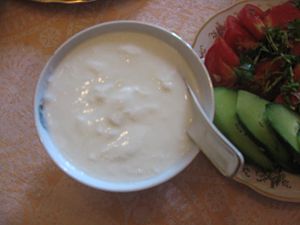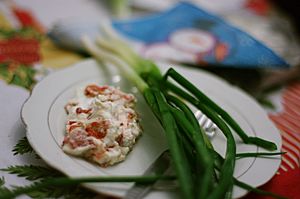Qatiq facts for kids


Qatiq is a special kind of fermented milk that comes from countries where Turkic languages are spoken. Think of it as a thicker, more solid version of yogurt, but not as thin as a drink like ayran. It's a popular food in many places!
Contents
What is Qatiq?
Qatiq is a dairy product made by letting milk ferment. This means good bacteria are added to the milk, which changes its sugar into lactic acid. This process makes the milk thicker and gives it a slightly sour taste. It's similar to how yogurt is made, but qatiq often has a firmer texture. People enjoy it in many ways, either on its own or as part of different dishes.
How is Qatiq Made?
Making qatiq is a simple process that takes a bit of time. First, milk is boiled and then cooled down to a warm temperature. Next, a small amount of old qatiq or a special starter is added to the warm milk. This starter contains the helpful bacteria needed for fermentation. The mixture is then left in a warm place for about 6 to 10 hours. During this time, the bacteria work their magic, turning the milk into qatiq.
Sometimes, people add natural colors to qatiq. For example, they might use red beets or cherries to give it a nice pink or red color. Once it's ready, qatiq can be kept in a cool place for a couple of days. If you keep it longer, it might get more sour. Even when it's sour, it can still be used in cooking, like adding it to rich soups. In Uzbekistan, a soup called chalop is made using qatiq.
Other Cool Products from Qatiq
Qatiq can also be used to make other interesting dairy products:
- Suzma: If you take sour qatiq and strain it through a cloth bag, the liquid drains out, and you are left with a thicker, creamy product called suzma. It's like a very thick, strained yogurt.
- Kurut: Suzma can be dried even further. When it's dry, it's often rolled into small, marble-sized balls. This dried product is called kurut. It's a way to preserve dairy for a long time and is often eaten as a snack.
Where Does the Name Come From?
The name "qatiq" and its variations are used in many different countries. Here are some examples of how it's called around the world:
- In Russia, it's known as катык.
- In Turkey, they call it katık.
- In Azerbaijan, it's qatıq.
- In Uzbekistan, it's qatiq.
- In Kazakhstan, it's қатық.
- In Turkmenistan, it's gatyk.
- The Crimean Tatars call it къатыкъ.
- The Uyghurs use the name қатиқ.
- In Bulgaria, катък is a thick spread, almost like mayonnaise, often used with other foods.

